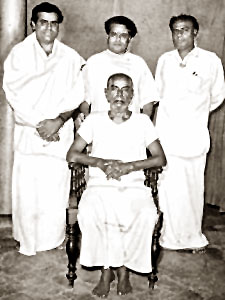 T. K. S. Brothers is a far-famed theatre company. Sankaran, Muthuswamy, Shanmugam, and Bhagavathi were the sons of T. S. Kannuswamy Pillai. He was a female impersonator who initiated them as young boys into acting. The first three brothers joined Sankaradas Swamigal`s Tattuva Minalochani Vidya Balasabha in 1918. Shanmugam proved a valuable asset for Swamigal, and rose to take on royal parts. Soon the siblings were identified as T. K. Shanmugam brothers. Swamigal once introduced all three brothers together in a scene, which received high acclaim. Later, they entered the troupes of Krishnaswamy Pavalar and Kandaswamy Mudaliar.
T. K. S. Brothers is a far-famed theatre company. Sankaran, Muthuswamy, Shanmugam, and Bhagavathi were the sons of T. S. Kannuswamy Pillai. He was a female impersonator who initiated them as young boys into acting. The first three brothers joined Sankaradas Swamigal`s Tattuva Minalochani Vidya Balasabha in 1918. Shanmugam proved a valuable asset for Swamigal, and rose to take on royal parts. Soon the siblings were identified as T. K. Shanmugam brothers. Swamigal once introduced all three brothers together in a scene, which received high acclaim. Later, they entered the troupes of Krishnaswamy Pavalar and Kandaswamy Mudaliar.
In 1925, they formed their own Bala Shanmugananda Sabha in Madurai. They emphasized physical, vocal, and musical training for the actors. Functioning as a full-time professional troupe, they hired halls for shows. Sometimes they stayed for many months at one venue and held continuous runs. In 1937, T. K. S. Brothers staged their first social play, Muthuswamy`s Gumastavin pen. This was filmed as Clerk`s Daughter in 1941. Success of this led to many more social dramas. Some contained radical views. A banner with a slogan like `Workers of the World Unite!` found a place on their front curtain. Other popular productions were Avvaiyar, Rajaraja Cholam, Manitan or `Man`, Andaman kaiti i.e. `Prisoner of the Andamans`, Uyiroviyam or `Living Painting`, Kalvanin kadali i.e. `Robber`s Lover`, Iratta Pasam i.e. `Blood Bond`, and Tamizh Selvam, performed in all corners of Tamil Nadu. They also staged two children`s plays. The names can be mentioned as Palappazham or `Jackfruit` and Appavin asai i.e. `Papa`s Desire`. In 1942, they organized a drama competition and a conference in which C. N. Annadurai participated.
In 1950, they renamed the company as T. K. S. Nataka Sabha. Instead of the old residential style, it assembled actors from various places for performances. A partial list of members drives home its impact on Tamil theatre and film. Some of the members can be named as N. S. Krishnan, S. V. Sahasranamam, K. R. Ramasamy, S. V. Subbiah, N. S. Balakrishnan, T. N. Sivadanu, A. P. Nagarajan, T. V. Narayanaswami, S. S. Rajendran, M. S. Draupadi, M. N. Rajam, and Kamalahasan. It introduced actresses on the Tamil stage for the first time. It toured many parts of India and abroad, where Tamil communities lived. Between 1925 and 1972, it staged 72 productions, of which about half were original scripts. It also cinematized many of them, among which the realistic Gumastavin Penn and the nationalistic Andaman Kaiti in 1952 fared very well.




